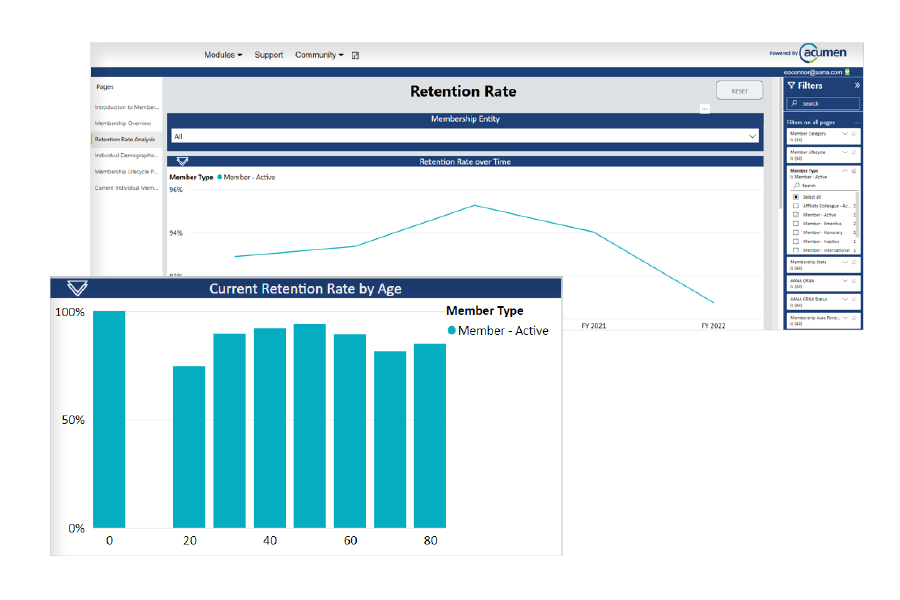While the past few years have certainly presented their fair share of challenges, they’ve also highlighted innovative ways associations have been able to flourish and create revenue growth despite uncertainty. Associations were able to rise to the challenges presented or exacerbated by the pandemic by responding to member priorities in new ways, from virtual events and networking opportunities to industry-specific solutions to member challenges that resulted in membership gains and revenue growth. One common denominator among some of the most innovative associations is recognizing the value of being data-centric and embracing data-informed business practices.
While almost every association strives for growth, what sets apart those who’ve had such successes and those who have yet to begin their data journeys? We recently had the opportunity to chat with an association professional with a unique role within our space: Chief Growth Officer. Eric O’Connor from the American Association of Nurse Anesthesiology (AANA) shared insights about his approach to making data-informed decisions and how he’s built a culture of analytics within his association on our Analytics in Action webinar and we’ve outlined his highlights and takeaways below.
The Growth Mindset
Eric O’Connor was new to the association space when he assumed the role of Chief Growth Officer at AANA. What wasn’t new to him was understanding the value of data and what’s necessary from an organizational standpoint to be able to tap into it.
Associations have a trove of valuable data, but too often that data is inaccessible because it’s stored in spreadsheets which are spread throughout the organization, making accessing insights next to impossible.
When he started at AANA, he learned that decisions were made based on anecdotal member preferences and behaviors gleaned from conversations and generalizations rather than data. But he knew in order to leverage the gold mine that is member data, he needed to being able to access, analyze and segment it into actionable insights and member experiences.
Associations tend to think of growth in terms of silos or departmental initiatives as opposed to adopting a growth mindset that spans the entire organization and all the opportunities for revenue growth, member engagement, and other KPIs that may not be evident until data insights reveal them. To tap into data and turn insights into growth opportunities, associations must foster a collaborative culture that prioritizes data over assumptions and democratizes access to data.
Analytical Culture
For Eric, an analytical culture was not just an important part of strategic data use, it was crucial to AANA’s growth. One of the main components of an analytical culture is data literacy across both staff and volunteer leadership. The first step is making sure everyone across the organization is comfortable with data—the terminology, the reasons data is valuable and the ways it can validate and invalidate assumptions.
Weaving data through everyday interactions is not only easy to do, but it’s the best way to strengthen your association’s collective data literacy.
Eric includes data in every conversation, whether at the board or strategic level or in routine interactions with team members that helps highlight the insights that data yields while also upping everyone’s comfort talking about and analyzing data.
Data dashboards help visually showcase data and provide opportunities to highlight specific information or trends that data reveals.
Another way to shift focus towards data and the ways it can help inform strategy and drive growth is to focus on wins. After all, everyone likes to win, and what better than a scoreboard to showcase wins? What analytics can be shared across the organization and/or in reports to highlight wins, or point to low-hanging-fruit? Also, what facts do the data convey—membership metrics like renewals and retention, registration targets, trends across certain demographics and many other types of drill-down insights.
Use Data to Inform Action
Weaving data into everyday conversations and strategic decisions underscores the value of data, and the opportunities it provides to glean insights and strategize solutions. One example Eric discussed was retention, specifically across various member segments.
Insight Revealed: AANA’s retention data revealed that they had a significant problem retaining members as they transitioned from student to early career membership. Drilling down on the retention rate by member type and retention rate by age revealed the pattern. It also revealed the fact that the declining retention rate for that segment had been going down for a decade, yet nobody had noticed it until they were able to have and analyze all their membership demographic and behavioral data in one place.
Action Taken: The association is now working towards implementing strategies to create a student member value proposition that students want to continue membership as they progress into the early career member category.
Additional examples of specific data trends revealing issues that can be identified as opportunities for growth include:
- Event attendance
- Survey responses compared to behavior as illustrated by relevant data
- The effectiveness of various marketing tactics
- Underperforming programs or benefits that could be easy targets for elimination
- Much more!
Turning to data to identify potential issues requiring attention or to measure performance in real-time to create continuous improvement strategies doesn’t mean that the voice of members is no longer important. Being able to compare what members say they want versus what the data reveals about their behavior helps fine-tune the member experience and optimize value in both the short and long term.
If you’re interested in hearing more about the ways AANA uses analytics to fuel revenue growth, you can watch the on-demand webinar. You can also download AANA’s case study for additional insights or schedule a call with one of our data-loving experts to learn how analytics can help fuel your association’s growth engine.





